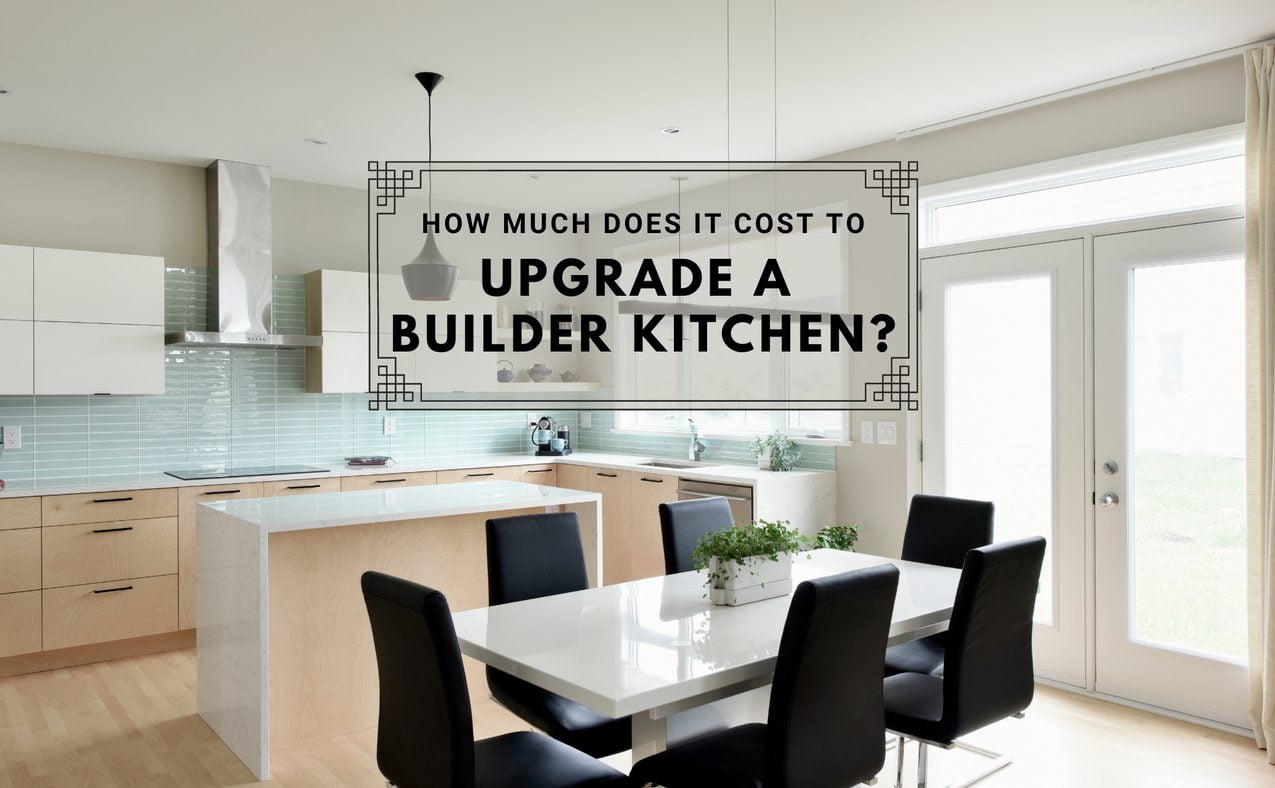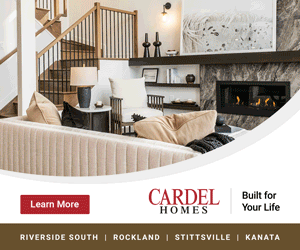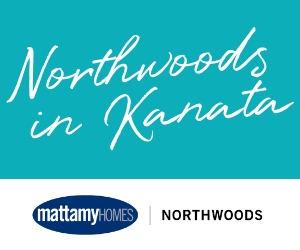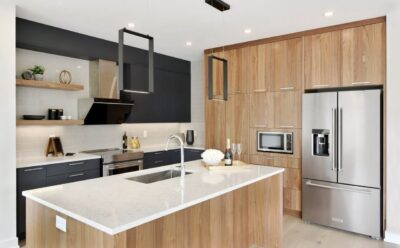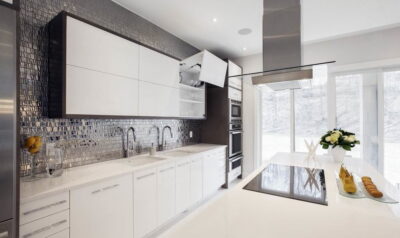How much does it cost to upgrade a builder kitchen? For homeowners working with a builder on a pre-construction home, it can seem impossible to gauge what your expenses will be. Not anymore.
Deslaurier Custom Cabinets has 40-plus years of industry experience and partners with many builders in the Ottawa area. With the expertise of Deslaurier design consultant Kevin Rosien, this article tackles the complex question of new-build kitchen costs head on.
It covers the six primary cost contributors of builder-grade kitchens:
- Cabinet door style
- Wood species
- Stain or paint colour
- Accessories, modifications and hardware
- Countertop material
- Kitchen layout
It also looks at upgrades and how much you can expect them to cost above a builder kitchen’s standard pricing. You’ll get a solid grasp of what the design process — and its budget sheet — looks like when working with a builder.
Standard builder-grade kitchens
Finding your kitchen’s base price
There’s a reason it’s so challenging to find cost estimates for builder kitchens online. That’s because the most truthful answer to the question, “How much does a builder-grade kitchen cost?” is, “It depends.”
The price tag to customize your kitchen depends on what your builder’s standard offerings are.
What does standard mean?
Standard offerings refer to the design selections included in your base model home. In other words, a standard kitchen is the kitchen already built into your pre-construction home’s purchase price.
Standard selections vary with every builder.
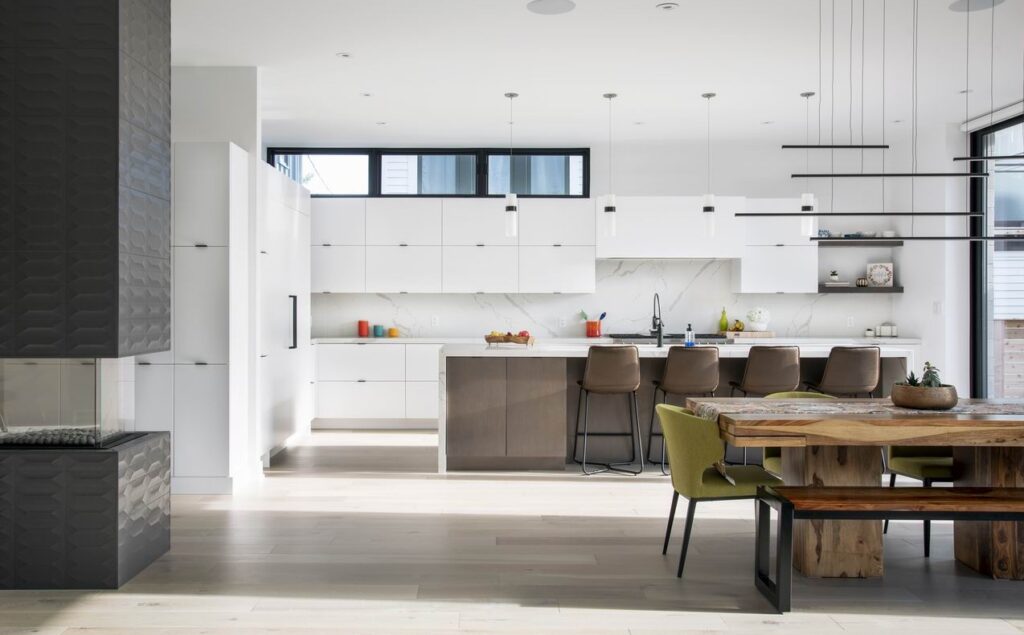
It makes sense then, that the first resource you need to determine your future kitchen’s cost is a list of your builder’s standard and upgrade selections. If you’ve already purchased your home, you should have a document that tells you this information. If you’re in the builder research stage, you’ll find some builders offer this information directly on their website and others don’t.
Reach out to your builder and ask for a specifications sheet of your kitchen’s standard features.
You’ll also want to find out what company is supplying your builder kitchen. For instance, Deslaurier partners with a host of builders in the Ottawa region and beyond. If your builder kitchen is from Deslaurier, you’ll work directly with a Deslaurier designer to customize and finalize your kitchen’s design.
Other home development companies operate differently, but it’s a good idea to know the businesses behind your builder home.
Redefining standard kitchens
It’s worth noting that “standard” has no negative connotation. Some clients have the mindset that upgrading is the only route to achieving a high-quality kitchen esthetic, but that’s simply not true.
“Standard is beautiful. Standard kitchens work. I’m not here to upgrade your kitchen. I’m going to show you a beautiful standard kitchen, and you can decide if the upgrades have value.”
— Kevin Rosien, Deslaurier design consultant
Kitchen upgrades: What are they?
Upgrades encompass every alternative design selection outside the builder’s standard offerings. If you want to, you can swap out every standard component of your builder-grade kitchen — for an additional cost.
Upgrades are opportunities to add more value to your kitchen, all while optimizing it to your lifestyle and preferred esthetic.
Let’s look at cabinetry hardware as an example. Buyers who come into the Deslaurier showroom for their builder kitchen design appointment will typically be presented with one to two boards of their builder’s standard offerings, each board showcasing about 10 to 20 unique hardware styles.
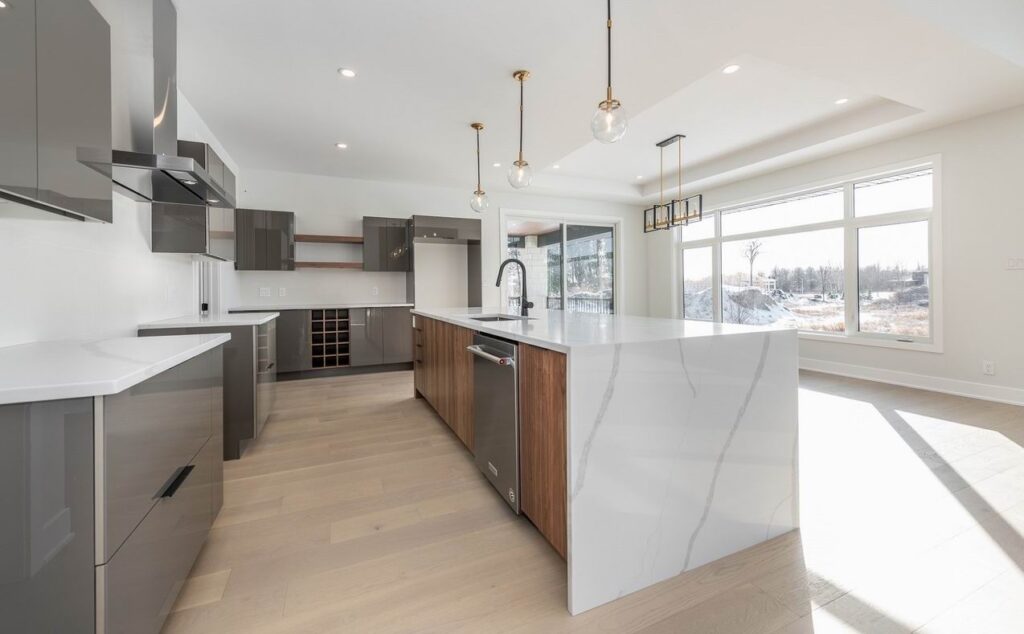
Elsewhere in the showroom there are rows and rows of hardware boards on display. In total, Deslaurier offers some 3,600 hardware options.
If you don’t like the pulls and knobs in front of you, you can walk around the corner to pick out any other hardware type you desire on display. That’s an upgrade. It will cost you more.
You can upgrade — or not upgrade — anything you like in your builder kitchen.
Everything hinges on your builder’s standard
Some people hear the word “upgrade” and their defences immediately go up. We understand. It can be daunting navigating upgrades without knowing how they work.
Contrary to popular belief, when it comes to upgrades, not everything is equal. To explain, let’s circle back to the linchpin of your kitchen’s total cost: your builder’s standard.
Here’s an example to illustrate: Builder A offers a standard laminate countertop. Builder B offers a standard granite countertop. Marjorie wants quartz countertops.
In the countertop world, laminate is an entry-level product and, typically, the most affordable countertop material out there. Laminate is made from particleboard with a plastic sheet glued to its surface. Granite and quartz are two other popular countertop materials and both are natural stone products (see more about the most popular kitchen countertops and other countertop choices).
With Builder A, let’s say Marjorie must pay $5,000 to upgrade from laminate to quartz. With Builder B, Marjorie must pay $1,000 to upgrade from granite to quartz. In this example, there’s a $4,000 difference for the exact same product.
Does that mean Builder A is more expensive than Builder B? Not necessarily.
Upgrading from laminate to quartz is a bigger jump to make than upgrading from granite to quartz. Why? Laminate and quartz are entirely different products — they’re apples and oranges. On the other hand, if granite is your starting point, moving to quartz is only a small step from one stone type to another.
What’s the takeaway here? Not all upgrades are equal. Everything is relative to your standard starting line. Upgrades aren’t the bad guys or the good guys. Upgrades are the means to customizing your kitchen the way you want it.
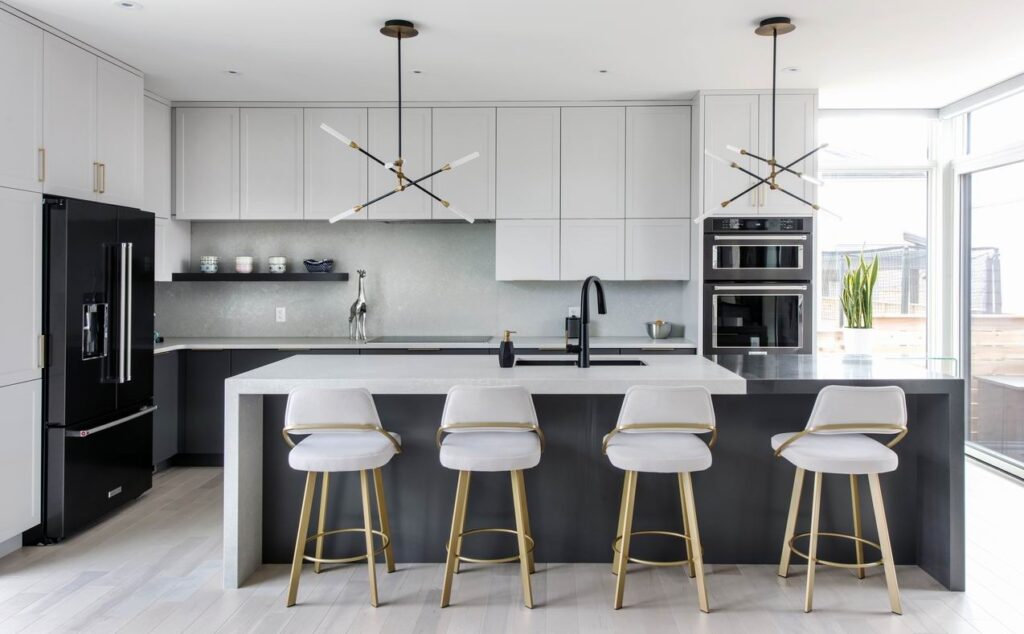
Delaying upgrades until post-close
Options, options, options. Buying a new construction home presents virtually endless design options. And here’s yet another: you may choose to delay upgrades until after your home closes.
It’s helpful to know that upgrades can be retrofitted into your kitchen after you’ve moved in. If you don’t have the budget for all the upgrades you want now, hiring an independent contractor at a later date is an alternative solution.
Keep in mind, though, most upgrades make more sense to complete at the time of construction.
For example, let’s consider the laminate to granite upgrade again. Some new homeowners think they’ll save money on materials and labour by hiring someone else post-close. What they don’t realize is that a countertop installation such as this inevitably affects your plumbing.
Specifically, top-mounted sinks that pair so well with laminate don’t work with granite at all. To upgrade your counters to stone after closing your home, you’ll probably need to fork out the cash not only for the granite countertop and installers but also for a new under-mount sink and plumber. So, what could have been a simple initial upgrade with your designer becomes a major overhaul later.
It’s not only the big-ticket items that are easier to get done from the get-go. Even small design modifications tend to snowball into hefty unplanned costs post-close.
Making changes — big or small — is simpler on Day 1 than Day 365. After all, there’s something to be said about the adage, “do it right the first time.”
Check out our 5 most worthwhile builder upgrades article for more tips on when (and when not) to delay upgrades.
6 major builder kitchen costs
To get a clearer picture of what a builder kitchen costs, let’s examine the six major cost contributors individually:
- Door style
- Wood species
- Stain or paint colour
- Cabinetry accessories, modifications and hardware
- Countertop material
- Kitchen layout
Door styles
Your cabinet’s door style has a starring role to play in your kitchen’s esthetic.
Typically, your builder will give you a handful of door styles to choose from, all of which count as standard. A popular standard package at Deslaurier includes four unique styles, namely, our Brookfield, Crestfield, Northfield and Urban door style:

Beyond these standard styles, Deslaurier has dozens of cabinet fronts available for upgrades.
For example, a typical first-level upgrade might be mitred cabinet doors (where the joints come together at a 45-degree angle instead of a 90-degree angle). These might cost you an additional $1,500. Next, you could upgrade to raised panel doors (where the centre panel raises to the height of the frame) for an extra $2,500. You can even combine these upgrades and choose a mitred raised panel door for $4,000 more.
The added dollars come from the extra manufacturing time it takes to create pieces with more elaborate designs and detail.
Wood species
Another major cost contributor to your kitchen is the wood species you choose for your cabinets. Your builder will likely present you with one to three standard options. While there are always exceptions, most builders’ standard wood species offerings are:
- Oak
- Oak and birch
- Oak, birch and maple
Oak is the entry-level wood species for cabinets. Why? It’s extremely common, and it’s extremely durable. Birch and maple are two other very popular, and often standard, wood species.
Without even considering alternative species, you’ll find a lot of esthetic variation between oak, birch and maple.
For example, consider the cosmetic difference of an oak (right) and birch cabinet front (left) side by side:

Even with the exact same stain, these doors look very different. You’ll notice the oak door has a distinctive, bold grain pattern while the birch door’s grain is subtle.
This just goes to show that in many cases, there’s no need to venture into the land of upgrades to nail your dream kitchen’s look.
However, if you choose to upgrade, you can expect another hardwood, like cherry or walnut, to come with a 15 to 40 per cent price increase.
The cost of wood species is based on harvesting ability and market demand.
It’s a walk in the park for Rosien to explain the price variation of wood species to his clients — literally:
“I tell my clients to take a walk in Gatineau Park. What will you see? 300 oak trees; 150 maple and birch trees; and, if you’re lucky, maybe 20 cherry trees. It’s only natural then, that cherry cabinets cost more than oak.”
The price difference is baked into the rarity of the product.
Stain or paint colour
What about colour? Deslaurier offers over 40 standard stain colours for custom cabinets in builder-grade kitchens.

Combining all of our wood species, door styles and stains, there’s over 20,000 potential cabinetry designs. A typical base builder kitchen will offer around 480 as standard options (three species x four door styles x 40 stains).
As seen in the oak vs. birch image, all stains look slightly different depending on which wood species they’re applied to.
While staining cabinets can achieve a rainbow of colours, the natural wood grain tends to show through. That’s why the most widespread colour upgrade is using solid paint over stain. Solid paints provide an opaque finish that covers up wood grain patterns.
A solid paint finish costs more than a stain because of the labour involved in the painting process. Staining cabinets is a three-step process while painting cabinets is an eight-step process, which is why opting for a solid paint colour over a stain generally costs 10 to 15 per cent more.
Cabinetry accessories, modifications and hardware
Cabinetry accessories, modifications and hardware are vital to the day-to-day working convenience of your kitchen.
Once again, what’s standard depends on your builder. There’s virtually no end to the cabinetry modifications you can make. Some common ones include:
- Fridge uppers and panels
- Angled corner cabinets (these offer deeper storage — standard corner cabinets may not fit your serving trays)
- Extra drawers
- False doors
- Bulkhead trim
When it comes to choosing (or not choosing) accessory and modification upgrades, Rosien wants to know all about the client’s lifestyle.
“I want to know your cooking style, eating habits, entertaining habits, family lifestyle — all of it.”
Are there young kids in the house? You may want to avoid placing a built-in range hood microwave right above the stove. The stove-microwave proximity creates a “crash zone” that can be dangerous for young kids.
Do you have tall family members? You may want to modify your kitchen island’s counter depth for seating — no one likes to bang their knees against cabinets.
Check out our best-selling kitchen cabinetry accessories article for more information.
As for hardware, builders customarily give clients an allowance per unit. In the showroom, your designer will show you a few dozen hardware styles within your allowance. Let’s say that allowance is $5.
Just around the corner, you’ll see thousands of other hardware from suppliers like Amtek, Berenson, Richelieu and more.

These hardware prices fluctuate widely depending on the material, colour and design of each unit. Believe it or not, some of these products are individually hand forged, which is highly skilled work that is reflected in the price. Hardware prices can range from $5 to $40 per unit.
If your builder allowance is $5 and you want an $8 drawer handle, you’ll have to pay the $3 difference.
Countertop material
Countertop material claims another big chunk of your builder kitchen budget.
Most often, builders offer either laminate or granite as a standard countertop material. More specifically, at Deslaurier there’s a standard “four-pack granite” package that includes four popular granite colours all within the same tier of quality, value and price.
For further style variety, you can upgrade to the six-pack granite package. These granite slabs come from farther away — in fact, the true culprit behind the majority of the cost difference between the four-pack and the six-pack spread is simply transportation fees. It costs a lot to ship a heavy natural stone slab across the world.
Below is an example of a builder’s countertop upgrade pricing list, where the standard selection is laminate. (This table represents example prices only. Prices also vary with kitchen layout.)
| 4-pack granite | 6-pack granite | 14-pack quartz | Quartz builder 10 | Quartz tier 1 | Quartz luxury |
| $3,100 | $3,700 | $3,750 | $5,325 | $6,120 | $7,700 |
| 1st-level upgrade | 19.4% increase | 21% increase | 71.8% increase | 97.4% increase | 148.4% increase |
———
Deslaurier’s popular and economic four-pack granite is the first-level upgrade available. As you can see, with a price increase of roughly 20 per cent, you can have access to either the six-pack granite or the 14-pack quartz. These two upgrades aren’t a massive financial leap to make. As we just highlighted, sometimes the price uptick is more about logistics than the product itself.
However, you can expect to pay more as the rarity of the product goes up. The quartz luxury package, for example, represents a whopping 148 per cent price increase, but gives you access to the crème de la crème of quartz — nothing but the most premium, exotic quartz from around the globe.
Kitchen layout
Not all builders allow kitchen layout changes.
Why not?
New construction homes have different timelines. You can buy two pre-construction homes today and one might be move-in ready within a year and the other set to break ground two years from now. Depending on your builder’s time frame, they may or may not permit you to make structural changes to your floor plan.
Ask your builder directly if altering the kitchen layout is possible. If it is, you may want to consider layout changes an honorary upgrade option.
Your designer can stretch out and switch up your floor plan to fit your needs. Of course, some things are set in stone because of building codes. Your designer will work with you to ensure all your layout changes are code-compliant.
Do be careful, though: layout changes can get expensive.
Even simply extending a kitchen island for extra eating space can add thousands to your final bill. An extended eating area requires extra cabinetry, more paint and further decorative modifications like glass front or false doors.
Creating your kitchen wish list

Here’s how the process works at Deslaurier. Our design consultants will book two appointments with you: the first to create your kitchen wish list and the second to sign off on it.
“I always emphasize to my clients that no final decision is made on the first appointment. The first meeting is all about touring the showroom, discovering what’s possible and making a wish list. There’s no pressure, and the tour is so thorough that there won’t be any surprises at the end.”
— Kevin Rosien, Deslaurier design consultant
Your designer will spend two to three hours with you on your first consultation, walking you through all your standard and upgrade options one by one.
By the end of the visit, you’ll have a clear understanding and visual idea of all your future kitchen’s design possibilities. Your homework is to decide what you want before appointment No. 2.
In the meantime, your designer will take your wish list of upgrades and put together a price list for your consideration. That way, you can compare your base kitchen costs and your hypothetical upgraded kitchen costs side by side.
That price sheet is the only concrete answer to the elusive “How much does a new kitchen cost?” question. Each new-build kitchen investment is based on the individual homeowner’s selections.
Generally, your designer will send these updated drawings and price sheets within four to five days after your first appointment.
At your second appointment, you’ll confirm your selections, sign off on the paperwork and call it a day. You should be in and out within the hour.
